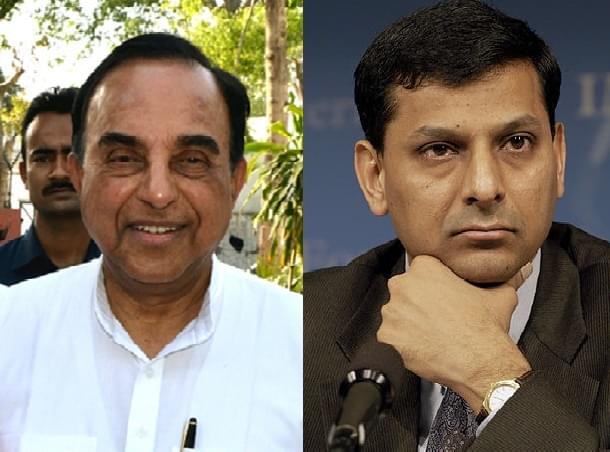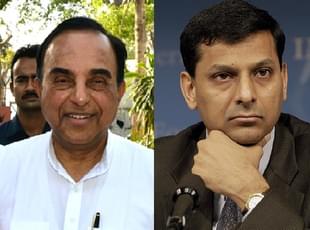Economy
Swamy Vs Raghuram Rajan: Both Are Off The Mark But The Latter Less So
Shanmuganathan Nagasundaram
May 14, 2016, 10:41 AM | Updated 10:40 AM IST
Save & read from anywhere!
Bookmark stories for easy access on any device or the Swarajya app.


How does one read into Subramanian Swamy’s demands for
firing RBI Governor Rajan? Does his claim of “killing the patient to bring down
the temperature” have any merit? If otherwise, should Rajan be given a second
term?
First, both Swamy and Rajan are considered “free
market” economists – at least by the fairy-tale definition of “free markets” in
India. Of course, if you ask any economist of the Austrian school, neither
would be considered one. That said,
Rajan is decidedly closer than Swamy to the position of the Austrian School in
a relative sense.
The figure below is a good summary of the four dominant
economic schools of thoughts. An overwhelming fraction (perhaps greater than
90%) of the economists we see today belong to the neo-Keynesian school (which
is to the left of shown Keynes’s position on economic issues). The reasons are
not hard to fathom – these economists advocate ever greater role for
governments in economic activity and the government rewards them with positions
of power and influence – a genuinely symbiotic relationship that has
proliferated over the decades. A better understanding of the figure below can
be obtained by reading my article “Saving India from the
Keynesians”
The root of the issue between Swamy and Rajan arises because
Swamy is a Keynesian (perhaps, the Samuelson influence?), while Rajan’s
position is closer to that of the Monetarist – after all, he is from the Chicago school.
So who is right
on their monetary stance?
Of course, both are wrong. Though Swamy is far worse than Rajan. A Swamy or his ilk as an RBI Governor would be a disaster for the country at this stage. How getting the wrong dogma between the ears during the formative years is clearly demonstrated by Swamy. For all of his obvious intelligence, Swamy believes prosperity and growth comes out of a printing press. What more needs to be said.
Besides, Swamy has never demonstrated any great
intelligence on the monetary side of economics. He was pretty much silent prior
to the 2008 crisis (at least, I have not been able to come across any papers
published prior to 2008) and to me that is always the litmus test. The 2008
crisis was in the making for years and any economist who had not forecast it
well ahead of time is simply not worth listening to. They are subjected to the
classical Keynesian blindspot and will always explain away these crises as six-sigma
events that cannot be forecast. And I presume, 75+ is too late a stage in life
to start with Ludwig von Mises and Murray Rothbard – even if he wants to, that
is.
Rajan is obviously different. He could clearly see
through the easy money policies under Alan Greenspan and Ben Bernanke and to
him, the US housing bubble was the “elephant in the room”. This makes him much
better prepared for the role of a Central Banker that Swamy can ever fathom.
So should Rajan
get a second term?
To start with, I presume he is open to one. Easily, he is the best RBI Governor we have ever had. Almost all “illustrious predecessors” have been found wanting even in their basic understanding of economics (like blaming inflation on growth, justifying subsidies, freebies, not encouraging governments to move towards a more market-oriented system etc). Besides, the others did not even understand the rationale for the cash reserve ratio (CRR) and that it’s really not an instrument of monetary policy. Rajan was perhaps the only RBI Governor in recent years who left CRR untouched in his entire tenure. Also, he has been the first to point out the pitfalls of the sovereign gold bond scheme and how the centre has to provide for the risk of price increases in its balance sheet. So far so good.
So what’s my beef with Rajan? Clearly, Rajan thinks
it’s the role of governments to run monetary policy and hasn’t even remotely
indicated as to why decisions on interest rates are best left to free markets.
After all, interest rates are the price of money and there’s no reason that the
judgment of a few sitting in Mumbai would be better than the combined decisions
of a billion borrowers and savers.
The other event that will hang like a “Sword of
Damocles” over his head is his decision to lease 1,000 tons of RBI gold to the
Bank of England. For all practical purposes, it’s gone the way of the
Bundesbank gold – gone forever, though RBI can continue to claim ownership on
paper. When the fractional reserve ownership of gold gets exposed over the next
few years, the RBI is going to be left holding useless pieces of paper in lieu
of the gold leased.
My guess, and its pure speculation at this point in
time, is that his training in the monetarist school makes him quite oblivious
to the role of gold in the world economy. That makes him a gullible participant
in the machinations of the Rothschilds and the BIS. But my guess, and again pure speculation, is
that his heart is in the right place and given sufficient time and evidence, he
is the one that is best placed to bridge the gap from what he knows to where he
needs to be. For almost all others in the “patriotic cabal”, it would be a
bridge too wide.
Unless, of course, the saffron brigade decides to go in for a Jim Grant! But then, if I were making such outlandish wishes, then I might as well hope that Swamy takes a liking to Rothbard!
Shanmuganathan N (aka Shan) is an Economist based in India. He is the author of the recently published book "RIP U$D: 1971-202X …and the Way Forward" and can be contacted at shan@plus43capital.com





